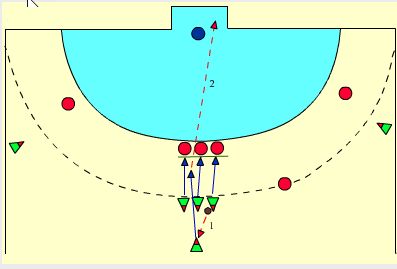Handball drills for technique attack / offense
- RO plays pass to MO
- MO plays pass to LO, RO starts to put pressure between LH and UL and feints to centre, putting extra pressure initially between LH and UL and then between MA-l and UL
- LO puts pressure between MA-r and MA-l, CS comes from the circle towards LO, LO plays a pass to CS
- CS plays pass immediately back to LO
- LO makes use of the space created and completes the pass.
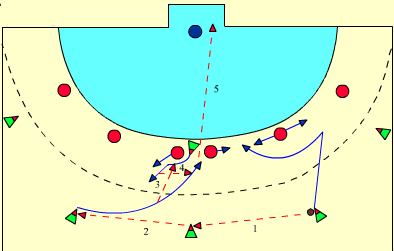
- The pass can be played to an in starting CS, MO, RO or RH. The ball is now played into the space where no player is present yet.
- The starting player must catch the ball in the run.
- Therefore, the pass should not be too hard and can best be played with a bounce (bottom pass).
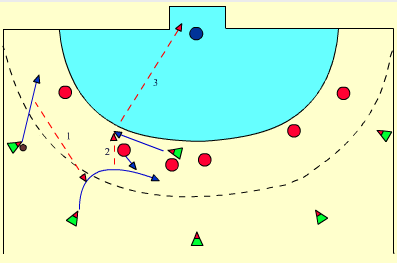
- RH puts pressure between MA-l and HL, MO puts pressure between MA-l and HL, RO starts in behind MO. This will cause MA-l and HL to go in, allowing a pass from RH to RO.
- CS puts pressure on MA-r, RO finishes off

- LO puts pressure to the middle, so UR joins, LH goes around HR to the circle
- LO plays pass to incoming LH
- LH rounds from circle, LH retrieves ball and joins LO row, LO joins LH row
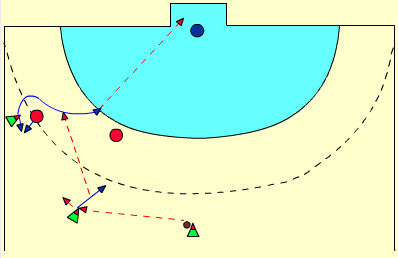
- This can be used against an opponent, who has focused all attention on the attackers and the ball.
- The team attacks and the coach calls a player to the transition area for "extra instructions". After a while, the attacking players shift the pressure to the other side of the field in order to get the defenders on that side.
- MO also moves to that side.
- RH must be free to play all the time, but must not be played.
- When the defense is in the desired position, the ball is passed to RH.
- RH now plays a pass to the closest builders.
- This is the signal for the coach to send the player into the field.
- MO runs to the defence and puts a barrage on the outside of the defence.
- The set-up player now plays a long pass to the player coming back from the change-over zone, who now has enough space to finish.
- This can also be used in the case of a temporary lock out
- If the team is in possession of the ball and the stoppage lasts about 10 seconds, pressure can be put on the defence in the same way and the excluded player can be sent back into the field, even with a few seconds delay.
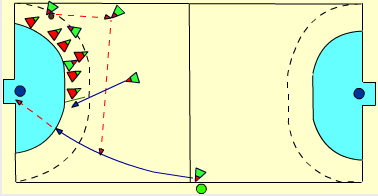
- If the opponent likes to make use of the quick counter attack, this might help
- The team is on the attack.
- Then the coach calls a player aside for so-called "extra instructions".
- Then the corner player on the other side plays a bad pass in the direction of her own half, with the ball bouncing slowly towards the exchange zone.
- Of course the team must comment on this.
- While the team argues, the opponents counter-attack quickly.
- In the meantime, the coach has followed the ball and passes the position to the player.
- At the right moment, the coach says "NOW", the player turns round and plays a pass to one of the free team-mates, who has stayed behind.
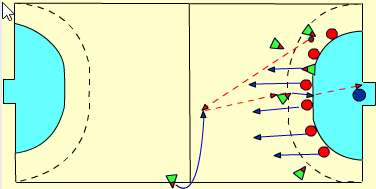
- The following might be fun to try out.
- At a signal, all players except the ball carrier lie down on the ground.
- The defence will probably be a little surprised and lose interest, allowing the ball carrier to throw at the goal of the bewildered goalkeeper
- Please note, however, that this can be considered unsportsmanlike conduct and should therefore only be used during a practice match.
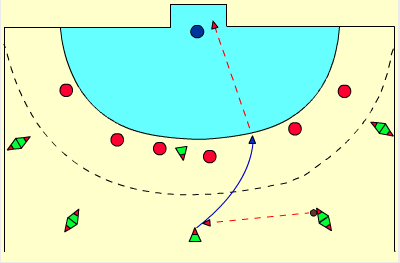
- Example of running routes from a 5-1 defense.
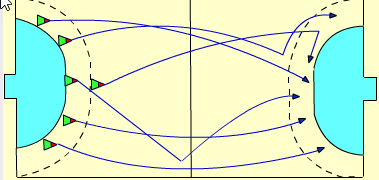
- Left player from the wall plays pass to MO, all players from the wall go backwards and place a bar on a corresponding defender.
- MO plays pass to in starting LH
- LH presses right next to HR and plays pass to in starting MO
- MO finishes
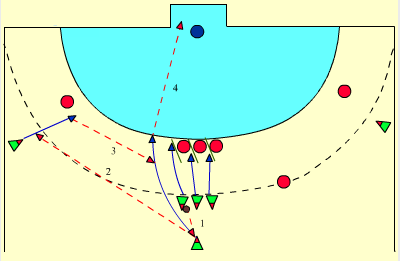
- A defender plays pass to KP.
- Immediately after the launch of the quick counter-attack, the defenders must try to stop the attack in a legal manner and must be back in time to defend
- The attackers must try to force a break-through.
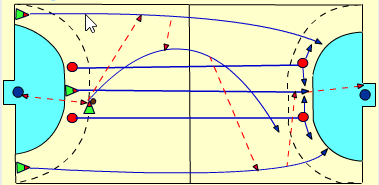
Free throw variation:
- 2 in wall (center and circle).
- Ball goes to set up.
- Threat.
- Outer wall blocks corner, other blocks construction.
- Corner starts, gets ball from set-up and runs between players.
- A player from the wall plays a pass to a starting player (in front of the wall)
- The players in front of the wall move backwards immediately after receiving the ball and stop,
- The player in front of the wall fences immediately after receiving the ball for a jump throw and completes the throw.
- The players in front of the wall must make sure that they do not make an attacking mistake by running into the defenders.
- Some defenders lower their arms when someone threatens to run into them, giving the thrower the space she needs to finish.
